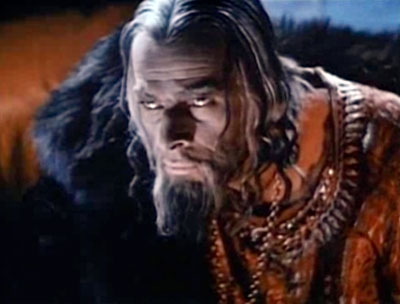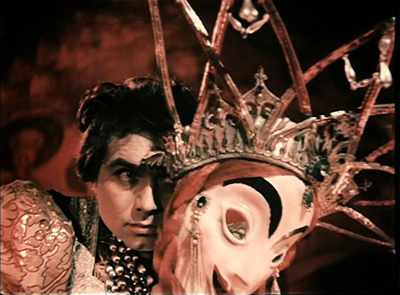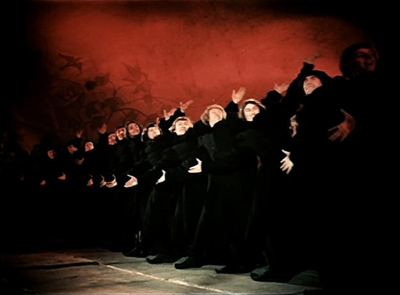Written for Criterion’s Current (web site), April 21, 2009. — J.R.
I recently had occasion to show Ivan the Terrible in a course on forties world cinema I’m teaching at Chicago’s School of the Art Institute, and found it more mind-boggling than ever. This has always been the Eisenstein feature that’s given me the most pleasure — the greatest Flash Gordon serial ever made as well as a showcase for the Russian master’s boldest graphics. But ever since I first saw it in the 1960s, this is a pleasure I’ve often had to apologize for, thanks to the vagaries and confusions of cold-war thinking. This thinking maintained that Eisenstein caved into Stalinist pressures, denounced the montage aesthetic that was central to his best work, and turned out an archaic, made-to-order glorification of a dictator.
Part of the problem has been reconciling the film’s multiple paradoxes — how much it functions as Eisenstein’s autocritique and apologia as well as an attack and glorification of Stalin, meanwhile combining elements of both high and low art at virtually every instant with its tortured angles and extreme melodrama. (Though portions of Part II could be termed inferior to Part I, the moment the film switches to color, using Agfa stock seized from the Germans during World War II, it moves into dizzying high gear, reminding us that Walt Disney was one of Eisenstein’s favorite filmmakers.) Some critics did take a slightly more nuanced view of things in Part II, but even a few of these writers, such as Dwight Macdonald, wound up adding homophobic invective to their charges, maintaining that Eisenstein’s homosexuality distorted his view of history — a dubious complaint that, as I later discovered, tended to oversimplify Eisenstein’s (bi)sexuality as well as the historical record. At least Orson Welles’s two mixed reviews of Part I — written in 1946, when he was a newspaper columnist and saw the film without subtitles at a special United Nations screening — placed proper emphasis on what might be called Eisenstein’s visual rhetoric, which tends to drown out most other considerations.
Thanks to the remarkably detailed scholarship of Joan Neuberger and Yuri Tsivian, who have both written invaluable monographs about the film and contributed fascinating audiovisual essays to the Criterion DVD editions, we now know that Ivan, far from being any sort of ideological collapse, was in fact Eisenstein’s most courageous gesture, above all in its highly ambivalent and often critical treatment of Stalin. Part I, which was milder overall, may have garnered the Stalin prize, but Part II, whose sexual and stylistic delirium went much further, was banned for a dozen years, following a now legendary February 1947 Kremlin meeting of Eisenstein and his lead actor, Nikolai Cherkasov, with Stalin, Molotov, and Zhdanov. It appears that Eisenstein agreed to make some cosmetic changes but then edited the film to suit himself, and died just afterward — having already vowed in his diary to work himself to death, after apparently being more appalled than pleased by Stalin’s initial endorsement of his project (according to Russian film scholar Leonid Kozlov).
Even if he never got around to shooting more than a few fragments of Part III (now lost, apart from a test), what Eisenstein left behind in the preceding two parts is surely one of the most complexly nuanced works in cinema history, simultaneously celebrating, critiquing, and analyzing Ivan, Stalin, and himself. What struck me most of all watching it this time was its shameless embrace of excess on all these fronts, registering both as a giddy kind of pop art and as a morbid exercise in medieval history. Despite its discarding of Eisenstein’s earlier montage aesthetic, I don’t think he ever made anything else in his career that was more personal or more expressive.





